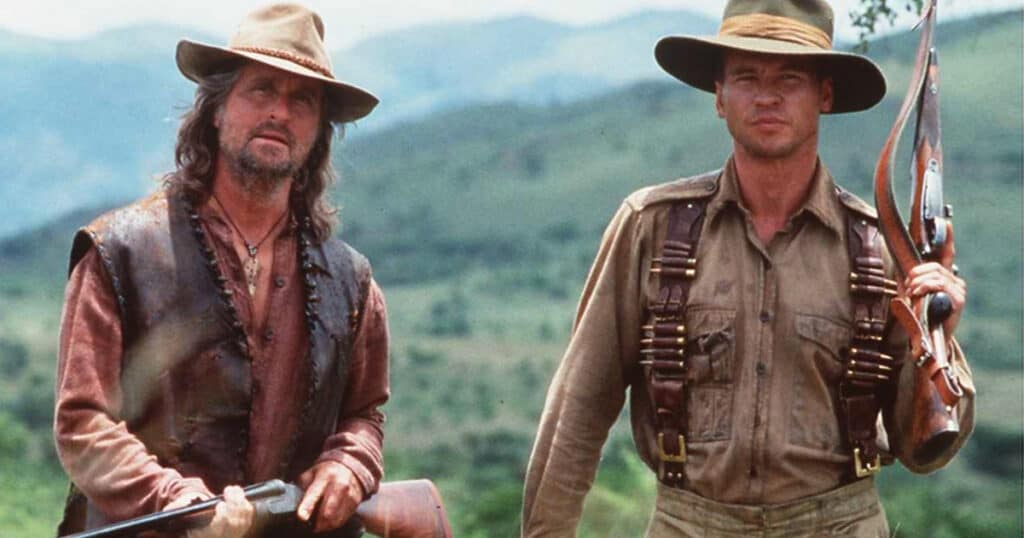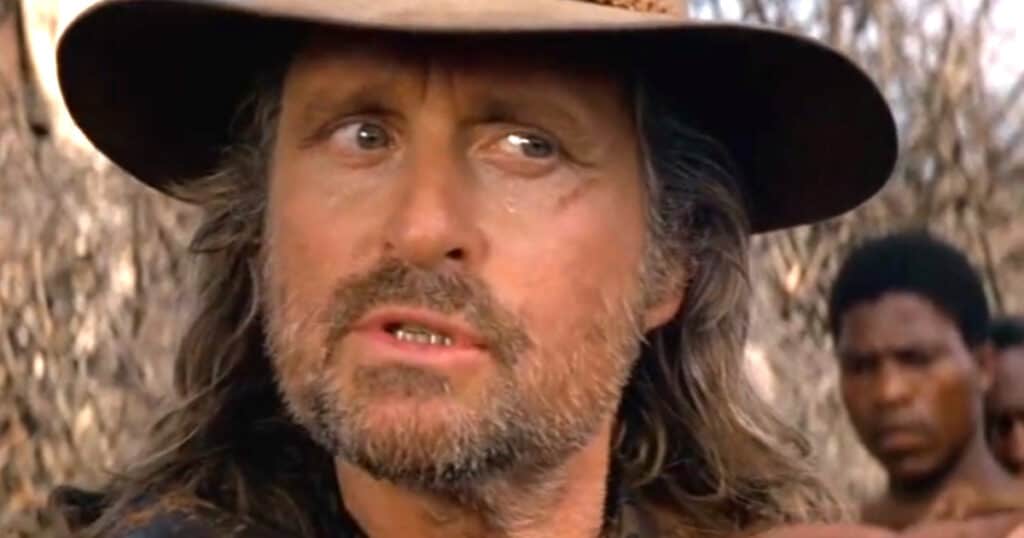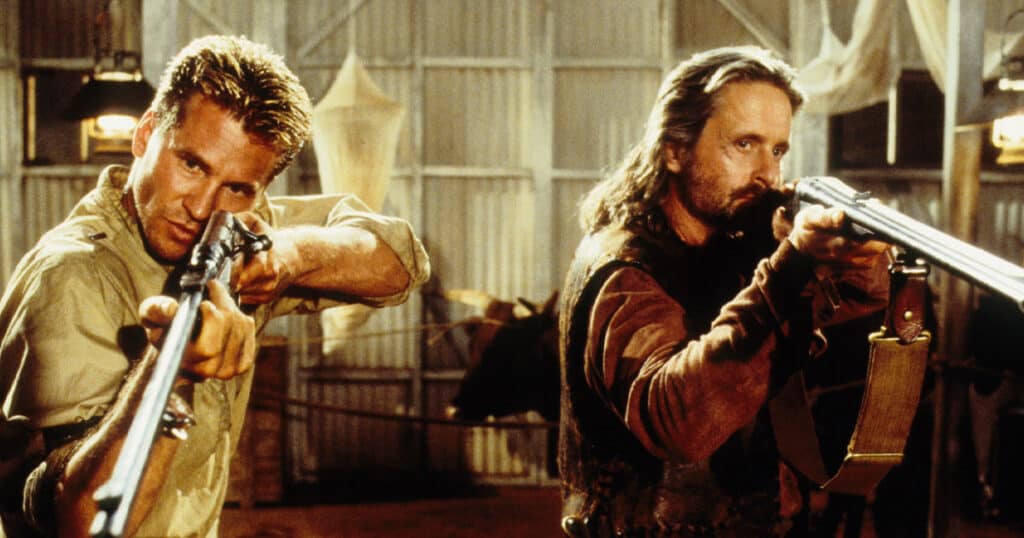Entertainment - Media News Watch originally published at Entertainment - Media News Watch
In 1898, Lt. Colonel John Henry Patterson, on behalf of Britain’s government, was sent to Africa to supervise the construction of a major railway bridge. The operation was located in the remote Tsavo Region of Kenya and employed thousands of workers. It also covered multiple miles of railroad track. John Patterson was ready to take on the daunting task. But just days after Patterson’s arrival, a pair of vicious male lions attacked and brutally attacked the workers. The rogue predators hunted the camp for nine months, dragging men out of their tents and killing them as sport. The workers feared them and called them “Ghost” or “Darkness”, believing they were vengeful spirits protecting their ancestral land against the British Empire. With the attacks only getting worse, it was up to John Patterson to defend his workers and end the lions’ reign of terror.
In 1907, Patterson wrote about his tumultuous battle with the lions in his semi-autobiographical book The Man-eaters of Tsavo. In 1952, Hollywood tried to bring to life this true story of terror with Bwana Demon. The later adaptation of Patterson’s memoir, directed by Stephen Hopkins and starring Val Kilmer and Michael Douglas as the real life badass Charles Remington and the famed engineer/hunter/real-life badass, was the one that really haunted us. How accurate is the Hollywood version? Let’s venture forward and find out WTF Really Happened to The Ghost and the Darkness.The film opens in England, 1898; John Henry Patterson is brought before Robert Beaumont, one of the bigwigs behind the Kenya-Uganda railway bridge construction project. Patterson is given the task of overseeing construction of a historic bridge over the Tsavo River under the pretext of expanding trade routes in the area and ending slavery. He accepts his role and departs to Africa, leaving behind Helena, a pregnant woman. Patterson was married at the time to Frances Helena Gray, but she was not pregnant. Bryan Patterson, their only child, was born in 1909. .
Similar character changes are made upon Patterson’s arrival to Africa. In the film we meet Angus Starling the British supervisor at the railway, Samuel the Kenyan foreman, and Patterson’s future right-hand man, and Dr. David Hawthorne the lead medic. All of these fictional characters were either inspired by or amalgamated with real people.
.[70% FACT-O-METER]Mere days after Patterson’s arrival, the attacks begin. The film accurately depicts the unusual brutality displayed by these lions. Workers were literally dragged out of their tents, and devoured at first sight. The medical tent, with its injured workers inside, was also attacked.
.[80% FACT-O-METER]Soon the attacks ramp up, with multiple workers being killed each night. The film shows how difficult it is to hunt these lions considering the size of this work camp. Patterson used a variety of tactics to keep the lions away. Patterson, heeding Samuel’s advice, had the workers build thorny fences around the camp – called bomas – to keep the Lions out. He sets up a strict curfew so that no workers are allowed to leave the camp after dark. He also lights small fires in the camp to deter lions.
.[100% FACT-O-METER]However, the rogue predators are unbothered by these obstacles. The lions, with their larger-than usual size and determination, were able either to leap over or crawl under the bomas. The workers were also not protected by the fires or tents. The lions start hunting in broad daylight very soon, which is a highly unusual behavior. The Tsavo man eaters, as well as the majority of lions that live in the area, are maneless. Scientists aren’t sure why, but one theory is that the hot, arid climate of the region renders manes ineffective. In an area that is devoid of abundant water sources, manes drain the lions’ limited resources. They’ve evolved so that they can grow without them.
.
However, director Stephen Hopkins didn’t have much of a choice when making this movie. The production used real lions and, for obvious reasons, it was not possible to cast untrained Tsavo Lions. Since most of the laborers were from India, they didn’t have any idea how to defend themselves against the lions. They saw the lions as vengeful spirit defending their land from the British Empire and believed Patterson was the cause of the attacks. They turned against him, refusing to work until the lions had been killed. [100% FACT-O-METER].
To maintain production, Patterson had to be creative. Patterson makes a box out of an old railway cart in one of the best scenes of the film. He uses it to trap one of the lions. Three Indian workers, armed only with rifles and using themselves as bait, locked themselves behind steel bar in the back of a trolley. The trap worked, which was surprising, but chaos soon broke out. The lion was enraged by the trap and repeatedly threw himself against the bars, threatening to collapse on the workers. One of the workers actually lost their hearing due to its ear-splitting roar. The terrified volunteers started shooting at the lion but missed every shot. The lion escaped, but the workers also escaped with their lives. The lion escaped, but the workers escaped as well. Beaufort rejects the request, fearing that it will make his country look weak. Charles Remington was created by Hollywood, just like many of the other characters in the movie. In reality, when work slowed down, the British government actually heeded Patterson’s request and sent over twenty Sepoys – or Indian riflemen – to assist in the hunt.

.[0% FACT-O-METER]Upon his arrival, Remington takes charge as the lead hunter. He must move the medic tent first, because the smell of rotting flesh is like catnip for the lions. In reality, it was Patterson’s idea to move the tent, and he did so fairly early during his time in Tsavo.
.
During the hunt the following day, Patterson uses a high-powered rifle that was given to him by Dr. Hawthorne. Patterson and Masai tribe, who are hunting with them, corner one of the killers lions. When Patterson tries to kill the lion, his rifle jams, and it escapes. This also happened to the original Patterson. The Masai tribe didn’t hunt with Patterson, but the faulty rifle belonged to him (not the doctor). [100% FACT-O-METER].
Later that night, Patterson and Remington attempt to lure the lions to the old hospital tent. They cover the walls in animal blood and littered the area with pieces. The lions attacked the new tent hospital after they saw through their bluff. Unbelievably, this actually happened to the real Patterson; the two lions were clever enough to avoid their trap and attack the new medic tent.
However, the film does deviate from the truth a bit. The film depicts a massacre, even though there were attacks on the medic tents. There were many deaths at the hands these lions but there was never such a large-scale killing in a single evening. At this point, the remaining workers have left the film. It’s up to Samuel, Remington and Patterson to hunt the beasts on their own. Remington and Patterson track the beast in the surrounding wilderness and find what appears to be the den of the beasts, completely filled with the skeletons of their previous kills. It’s a horrific sight, and lends a supernatural terror to the onslaught wrought by these lions. [100% FACT-O-METER]
Ultimately, this part of the movie is – to a degree – fabricated. Patterson never found the den of lions during his first trip to Africa, which is when this story takes places. Patterson took a picture of the reported lion’s den, but no one has been able to confirm its existence in the years since. Patterson took a photo of the reported den of lions, but no one has ever been able confirm its existence. It works. Remington saves his life at the last second, and the first man-eater is officially killed. His life is saved by Remington at the last second, and the first man-eater is officially killed.
Although this scene is largely fictional, there are some bits of truth here. Patterson did indeed set up a scaffold to use as a hunting stand. He didn’t use live baboons as bait but a dead donkey. Patterson shot the lion, but did not kill it. According to his book the lion returned several nights later and Patterson, using a stronger rifle, was finally able take down the beast. [0% FACT-O-METER].
With the first lion officially dead, Remington, Samuel, and Patterson celebrate. However, the joyous celebration is short-lived, as the second lion – perhaps driven by vengeance – kills Remington in his sleep. [50% FACT-O-METER]Considering Remington is a fictional character, it’s safe to say this scene never happened.
.[50% FACT-O-METER]The climax of the film diverges a bit from reality as well. The film’s climax also diverges from reality. Samuel and Patterson lured the beast out when they cremated Remington’s remains. Patterson fires a number rounds at the lion who seems unaffected. Patterson scrambles up a tree but the lion is not far behind. The hunt for the last beast took a few weeks, and was far less exciting. Patterson, like the first lion he shot, lured this lion out of hiding by using a dead goat as bait. The lion was able to escape and remained hidden for the next 11 days. Patterson and his small group of troops eventually caught up with the lion, and were able to shoot it several more times. The beast managed to escape once again. Patterson finally killed the lion the next day after he tracked it down. The beast was finally taken down with nine rounds.
The Tsavo man-eaters hold a unique position in history. Although some historians dispute these numbers, they have never been officially discredited. Even though some historians dispute these numbers, it has never officially been discredited.
The reason behind the lions’ bloodlust is also up for debate. Some historians think they developed a taste of human flesh because of the Arab slave caravans which often passed through the area. The lions ate the bodies of those who died during the brutal journey. This may seem like a minor issue, but it would have made the hunter a bad lion. Humans, in contrast to typical prey like zebras, are much slower and – generally speaking – easier to kill.[70% FACT-O-METER]Overall,
The Ghost and the Darkness

gets a lot of the story details correct. Since most of the information we have about this story is from Patterson’s book, it’s safe for us to assume that some details were exaggerated (and perhaps even a little self-aggrandizing) in the name of entertainment. The Ghost and the Darkness
, however, is not only a thrilling and expertly-told retelling of an incredibly terrifying ordeal but also a factual one. It’s safe say that
The Ghost and the Darkness[40% FACT-O-METER] has more truth than fiction.
Entertainment - Media News Watch originally published at Entertainment - Media News Watch



